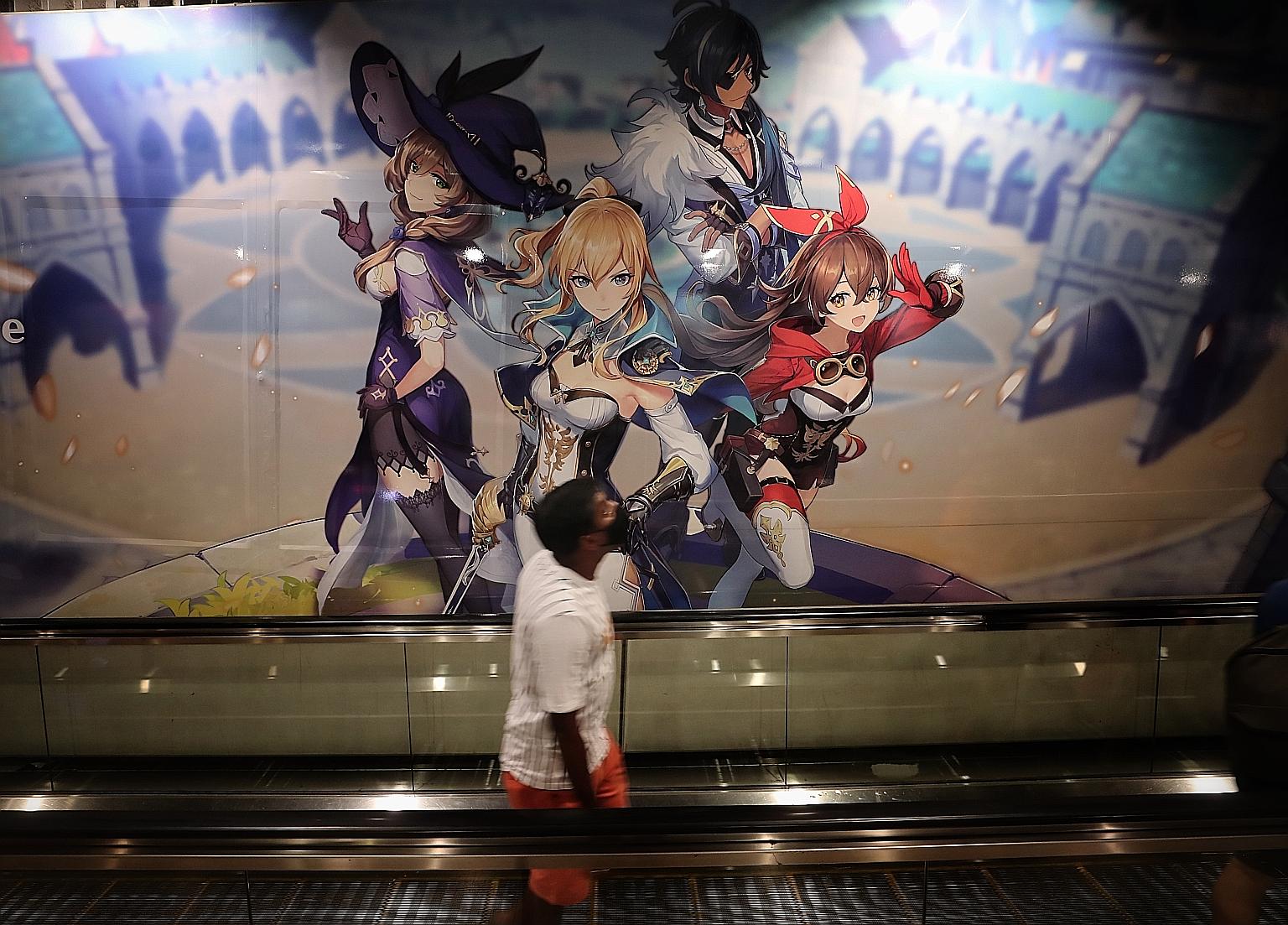Mobile gaming ads abound as industry's popularity grows
They appear at MRT stations, bus stops, and are screened in cinemas
Sign up now: Get ST's newsletters delivered to your inbox

A mural advertisement for the mobile game Genshin Impact at Serangoon interchange in October. The growing presence of such ads reflects the rising profitability of mobile games and the fortunes of their developers.
ST PHOTO: KELVIN CHNG
Follow topic:
The mobile gaming market in Singapore is now so lucrative that companies appear to be buying more public outdoor advertisements for them. Such ads were uncommon a decade ago.
This comes even as concerns rise over gambling-like elements called loot boxes commonly found in these advertised games.
The latest notable campaign was for the popular mobile game Genshin Impact launched in September. Large murals were seen on the walls of the linkway between the North East Line and Circle Line platforms at Serangoon interchange, as well as at Dhoby Ghaut and Jurong East MRT stations.
Ads for other mobile games like 2019's Overhit and Yokai Kitchen have appeared at bus stops and have been screened in cinemas.
While exact figures are not available, game industry experts said such ads were not so common a decade ago. Their growing presence now reflects the rising profitability of mobile games and the fortunes of their developers.
According to mobile consultancy App Annie, consumer spending here within gaming apps has seen a steady growth over the past five years. In 2019, mobile gamers in Singapore spent over US$332 million (S$439 million) on in-app purchases on games downloaded from Apple's App Store and Google Play.
That figure is forecast to hit US$414 million for 2020, a 25 per cent year-on-year increase.
Many mobile games tend to be free to download but encourage players to make small purchases in-game with real cash.
One of the more profitable ways to get gamers to part with their money is loot boxes, which have random rewards and are likened to slot machines in casinos, with similar lights and sounds.
Genshin Impact, a free-to-download game with loot boxes, is estimated to have made more than US$100 million globally within two weeks of its launch in September, rivalling the box office receipts for some Hollywood movies in pre-pandemic times.
Loot boxes are a huge money-making business for video games, so much so that those in sports games form a growing portion of the revenue of game publisher Electronic Arts (EA).
In fiscal year 2017, a mode in the Fifa (football), NHL (US-Canada National Hockey League) and Madden (American football) games that contains loot boxes made up 16 per cent of the company's revenue. This grew to 21 per cent in 2018 and in 2019, it was 28 per cent, or nearly US$1.4 billion of EA's total net revenue of about US$5 billion for that year.
An App Annie spokesman said that despite Singapore being one of the smallest markets in South-east Asia in terms of mobile game downloads, it is second only to Thailand in mobile game consumer spending.
"(This) makes it an attractive market for launching new mobile game titles as it has relatively higher spending power and revenue per download compared with the rest of the region," said the spokesman.
This spending power was demonstrated when Genshin Impact was released here.
-
$439m
What mobile gamers in Singapore spent in 2019 on in-app purchases.
$547m
What they are projected to have spent in 2020.
It became the second most downloaded game here in the first half of October following its Sept 28 launch, while it was the top game by consumer spend during the same period.
Mr Yasser Ismail, associate vice-president of strategy for Apac at media agency Essence, felt the increase in outdoor ads was mostly driven by revenue from mobile games, which have become more prevalent with tech advancements.
"The increase in ads is mainly based upon gaming consumption. Because there are more gamers, game developers have more budgets now and they can launch integrated marketing campaigns which do not just consist of digital ads, but also awareness campaigns and outdoor advertising," said Mr Yasser.
"It's something that perhaps wasn't as prevalent 10 years ago, as mobile phones didn't have the ability then to run such games.
"Now any mid-tier phone can run games with good graphics."
Mr Yasser said the outdoor advertisements were likely being used by game developers to create awareness for their brand and games.
Others, like Mr Lai Tuck Weng, founder of marketing consultancy Edge Digital, agreed, saying: "When it comes to outdoor advertising for game developers, it's not just about getting users to play their game, even though that is sufficient to run the business.
"It is also about building their brand and presence; they want to make themselves known and entrenched in the minds of players."
Mr Lai, whose firm specialises in gaming, technology and mobile apps, added that despite digital ads being more targeted, game developers are likely making use of more outdoor ads now because they can afford to do so.
A check on some advertising services' websites showed that an advertising campaign similar to that of Genshin Impact's in Serangoon could cost at least $50,000 and go above $100,000 for a display of four weeks.
Ms Tianyi Gu, marketing lead for mobile at games and e-sports analytics firm Newzoo, said that with Apple phasing out its Identifier for Advertisers - that the company attaches to each iPhone for third parties to track users for advertising - game developers will increasingly look for alternatives to reach a wider audience.

